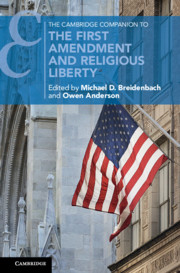Book contents
- The Cambridge Companion to the First Amendment and Religious Liberty
- Cambridge Companions to Law
- The Cambridge Companion to the First Amendment and Religious Liberty
- Copyright page
- Dedication
- Contents
- Notes on Contributors
- Acknowledgments
- Introduction
- Part I Philosophical Foundations
- Part II Historical Interpretations
- 4 Religious Exercise and Establishment in Early America
- 5 The Historical Context of the Religion Clauses of the First Amendment
- 6 Religious Tests, Loyalty Oaths, and the Ecclesiastical Context of the First Amendment
- 7 Church and State in the Nineteenth Century
- 8 The First Amendment Religion Clauses in the United States Supreme Court
- Part III Law, Politics, and Economics
- Index
4 - Religious Exercise and Establishment in Early America
from Part II - Historical Interpretations
Published online by Cambridge University Press: 17 December 2019
- The Cambridge Companion to the First Amendment and Religious Liberty
- Cambridge Companions to Law
- The Cambridge Companion to the First Amendment and Religious Liberty
- Copyright page
- Dedication
- Contents
- Notes on Contributors
- Acknowledgments
- Introduction
- Part I Philosophical Foundations
- Part II Historical Interpretations
- 4 Religious Exercise and Establishment in Early America
- 5 The Historical Context of the Religion Clauses of the First Amendment
- 6 Religious Tests, Loyalty Oaths, and the Ecclesiastical Context of the First Amendment
- 7 Church and State in the Nineteenth Century
- 8 The First Amendment Religion Clauses in the United States Supreme Court
- Part III Law, Politics, and Economics
- Index
Summary
Founders of the earliest American colonies considered religious piety an essential civic virtue and therefore continued the tradition of religious establishment found in Britain and other Protestant countries. New sects and denominations (especially Quakers and Baptists) contended against Congregationalist and Anglican establishments throughout the colonies. Though prominent dissenters Roger Williams and William Penn founded colonies respecting religious liberty, the decline of religious establishment elsewhere was owed primarily to changes in British law, commercial and political expediencies necessary for increasingly diverse immigrant populations, and, in the case of Anglican establishments, the difficulty of securing ordination and a self-sustaining parish. Though Roman Catholics enjoyed some degree of toleration, enthusiastic Protestant identity on both sides of the Atlantic further reduced Catholic rights and liberties. Jews enjoyed some limited degree of toleration, but only in a handful of colonies.
Keywords
- Type
- Chapter
- Information
- Publisher: Cambridge University PressPrint publication year: 2020

